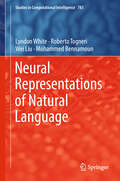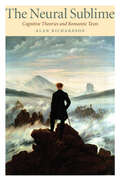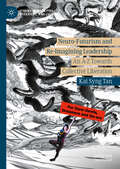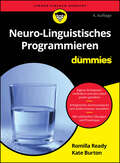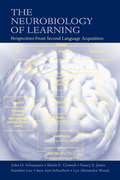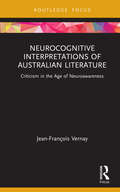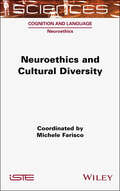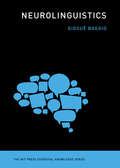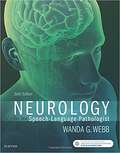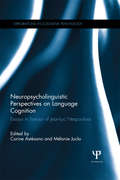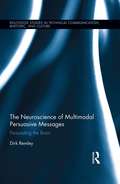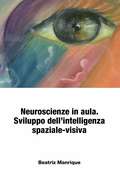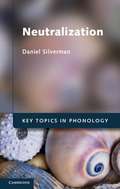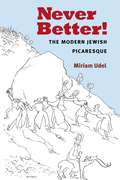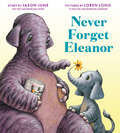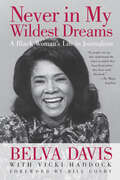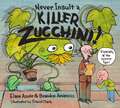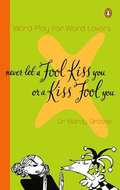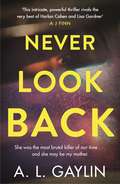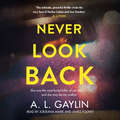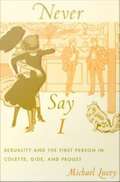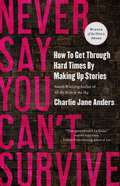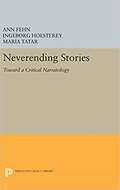- Table View
- List View
Neural Representations of Natural Language (Studies in Computational Intelligence #783)
by Lyndon White Roberto Togneri Wei Liu Mohammed BennamounThis book offers an introduction to modern natural language processing using machine learning, focusing on how neural networks create a machine interpretable representation of the meaning of natural language. Language is crucially linked to ideas – as Webster’s 1923 “English Composition and Literature” puts it: “A sentence is a group of words expressing a complete thought”. Thus the representation of sentences and the words that make them up is vital in advancing artificial intelligence and other “smart” systems currently being developed. Providing an overview of the research in the area, from Bengio et al.’s seminal work on a “Neural Probabilistic Language Model” in 2003, to the latest techniques, this book enables readers to gain an understanding of how the techniques are related and what is best for their purposes. As well as a introduction to neural networks in general and recurrent neural networks in particular, this book details the methods used for representing words, senses of words, and larger structures such as sentences or documents. The book highlights practical implementations and discusses many aspects that are often overlooked or misunderstood. The book includes thorough instruction on challenging areas such as hierarchical softmax and negative sampling, to ensure the reader fully and easily understands the details of how the algorithms function. Combining practical aspects with a more traditional review of the literature, it is directly applicable to a broad readership. It is an invaluable introduction for early graduate students working in natural language processing; a trustworthy guide for industry developers wishing to make use of recent innovations; and a sturdy bridge for researchers already familiar with linguistics or machine learning wishing to understand the other.
The Neural Sublime: Cognitive Theories and Romantic Texts
by Alan RichardsonWinner, 2011 Alpha Sigma Nu Book Award in Literature and Fine ArtsThe Neural Sublime brings recent work in cognitive neuroscience to bear on some famously vexed issues in British Romantic studies. In exciting and unprecedented ways, Alan Richardson demonstrates how developments in the neurosciences can transform the study of literary history. Richardson presents six exemplary studies, each exploring a different intersection of Romanticism and the sciences of the mind and brain: the experience of the sublime and the neuroscience of illusion; the Romantic imagination and visual imaging; the figure of apostrophe and linguistic theory; fictional representations of the mind and "theory of mind" theory; depictions of sibling incest and neo-Darwinian theories of mental behavior; and representations of female speech and cognitive developmental psychology. Richardson’s insightful analysis opens fresh perspectives on British Romanticism, pointing scholars to new developments in cognitive literary studies. He combines elements of new historicist analysis with original—and much-needed—models for understanding language, subjectivity, and social behavior. Far from signaling a departure from the prevalent critical approaches of new historicism, Richardson argues, cognitive theory presents an essential complement to them.The Neural Sublime features an array of cognitive and neuroscientific approaches, providing an engaging and readable introduction to the emergent field of cognitive literary studies.
Neuro-Futurism and Re-Imagining Leadership: An A-Z Towards Collective Liberation (Studies in Mobilities, Literature, and Culture)
by Kai Syng TanThis book is a rip-roaring manifesto that re-claims ways to think about and do ‘leadership’. Colliding mobilities, neuro-queering, the arts and culture, critical leadership studies, social justice, creative pedagogy, futurity and Daoist cosmology for the first time, the book proposes ‘neuro-futurism’ as a beyond-colonial, heuristic change-making tool-kit for individuals and institutions. Celebrating the Dangerous, Demeaning and Dirty labour of Deviant/Defiant culture-workers often side-lined in (leadership) scholarship across 26 break-neck chapters and 39 images, this book challenges white-supremacist-cis-het-neuro-normative-capitalist-patriarchal forms of power and knowledge. Punchy, punching up and pulling no punches, it is a call to arms, feet, sole-soul, to co-create tables/houses/worlds that profit (neuro-)divergent people, planet, poetry and play. The deadline is 2050, so we’re running out of time. Are you ready for an extra-ordinary adventure?
Neuro-Linguistisches Programmieren für Dummies (Für Dummies)
by Romilla Ready Kate BurtonÖffnen Sie Ihr Denken für neue M??glichkeiten! M??chten Sie andere Menschen besser verstehen und sich ihnen gegenüber besser verständlich machen? Dann ist dieses Buch genau das richtige für Sie. Romilla Ready und Kate Burton zeigen Ihnen, wie Sie mit NLP Ihre Kommunikation mit anderen erfolgreich gestalten k??nnen und Ihre Ziele leichter erreichen. Sie erfahren, was es mit »Landkarten«, »Ankern«, »Zeitreisen« oder »Rapport« auf sich hat, und werden schon bald merken, wie Sie einen neuen Blick auf Ihre Umwelt werfen und wie positiv sich Ihre Kommunikation mit anderen entwickelt. Sie erfahren Wie Sie Ihre Ziele mit neuer Energie und Überzeugung erreichen Wie Sie sich Geh??r für Ihre Botschaft verschaffen Wie Sie Zweifel überwinden und mehr Zufriedenheit erlangen
The Neurobiology of Learning: Perspectives From Second Language Acquisition (Language Learning Monograph Ser.)
by John H. Schumann Sheila E. Crowell Nancy E. Jones Namhee Lee Sara Ann SchuchertThis book constitutes a timely contribution to the existing literature by presenting a relatively comprehensive, neurobiological account of certain aspects of second language acquisition. It represents the collaborative efforts of members of the Neurobiology of Language Research Group in the Applied Linguistics and TESL Department at UCLA. Members of the group are trained in neurobiology and then use this knowledge to develop biological accounts of various aspects of applied linguistics.The volume avoids the corticocentric bias that characterizes many brain-language publications--both cortical and subcortical structures receive their appropriate attention. In addition, it demonstrates that enough is presently known about the brain to inform our conceptualizations of how humans acquire second languages, thus, it provides a refreshingly novel, highly integrative contribution to the (second) language acquisition literature.The goal of the research program was based on the need to draw more links between the neurobiological mechanisms and second language acquisition. As such, the book promotes a neurobiology of language that starts with the brain and moves to behavior. The fundamental insights presented should guide second language acquisition researchers for years to come.
Neurocognitive Interpretations of Australian Literature: Criticism in the Age of Neuroawareness (Routledge Focus on Literature)
by Jean-François VernayThis unique book on neurocognitive interpretations of Australian literature covers a wide range of analyses by discussing Australian Literary Studies, Aboriginal literary texts, women writers, ethnic writing, bestsellers, neurodivergence fiction, emerging as well as high- profile writers, literary hoaxes and controversies, book culture, and LGBTIQA+ authors, to name a few. It eclectically brings together a wide gamut of cognitive concepts and literary genres at the intersection of Australian literary studies and cognitive literary studies in the first single-author volume of its kind. It takes Australian Literary Studies into the age of neuroawareness and provides new pathways in contemporary criticism.
Neuroethics and Cultural Diversity
by Michele FariscoThere is a growing discussion concerning the relationship between neuroethical reflections and cultural diversity, which is among the most impactful factors in shaping neuroethics, both as a scientific discipline and a social enterprise. The impacts of culture on science and its public perception are particularly relevant to neuroethics, which aims to facilitate the creation of an interface between neuroscience and society at large. Time is ripe for neuroethics to review the influence of the culturally specific contexts from which it originated (i.e. North America and Western Europe) and to also include other cultural perspectives in the discussion. This book illustrates a convergent approach among different cultures in identifying the main issues raised by neuroscience and emerging technologies. This should be taken as a starting point for advancing in the search for shared solutions, which are, if not definitive, at least sufficiently reliable to be translated into democratic deliberative processes.
Neurolinguistics (The MIT Press Essential Knowledge series)
by Giosue BaggioAn accessible introduction to the study of language in the brain, covering language processing, language acquisition, literacy, and language disorders.Neurolinguistics, the study of language in the brain, describes the anatomical structures (networks of neurons in the brain) and physiological processes (ways for these networks to be active) that allow humans to learn and use one or more languages. It draws on neuroscience, linguistics—particularly theoretical linguistics—and other disciplines. In this volume in the MIT Press Essential Knowledge series, Giosuè Baggio offers an accessible introduction to the fundamentals of neurolinguistics, covering language processing, language acquisition, literacy, and speech and language disorders. Baggio first surveys the evolution of the field, describing discoveries by Paul Broca, Carl Wernicke, Noam Chomsky, and others. He discusses mapping language in &“brain time&” and &“brain space&” and the constraints of neurolinguistic models. Considering language acquisition, he explains that a child is never a &“blank slate&”: infants and young children are only able to acquire specific aspects of language in specific stages of cognitive development. He addresses the neural consequences of bilingualism; literacy, discussing how forms of visual language in the brain differ from forms of auditory language; aphasia and the need to understand language disorders in behavioral, functional, and neuroanatomical terms; neurogenetics of language; and the neuroethology of language, tracing the origins of the neural and behavioral building blocks of human linguistic communication to the evolution of avian, mammalian, and primate brains.
Neurology for the Speech-Language Pathologist (Sixth Edition)
by Wanda G. WebbThe concise, easy-to-understand Neurology for the Speech-Language Pathologist, 6th Edition provides students and clinicians with a practical guide for the study and understanding of neurology in speech-language pathology (SLP). Correlated with clinical syndromes and diseases seen in SLP, it gives you a solid understanding of the nervous system, including: development of the nervous system, organization of the brain, protective mechanisms, descending motor and ascending sensory pathways, and cranial nerves. New content, case studies, and a strong clinical focus make this new edition essential as you move into practice.
Neuropsycholinguistic Perspectives on Language Cognition: Essays in honour of Jean-Luc Nespoulous (Explorations in Cognitive Psychology)
by Corine Astesano Mélanie JuclaThis book brings together experts from the fields of linguistics, psychology and neuroscience to explore how a multidisciplinary approach can impact on research into the neurocognition of language. International contributors present cutting-edge research from cognitive and developmental psychology, neuropsychology, psycholinguistics and computer science, and discuss how this contributes to neuropsycholinguistics, a term coined by Jean-Luc Nespoulous, to whom this book is dedicated.Chapters illustrate how researchers with different methods and theoretical backgrounds can contribute to a unified vision of the study of language cognition. Reinterpreting neuropsycholinguistics through the lens of each research field, the book demonstrates important attempts to adopt a comprehensive view of speech and language pathology.Divided into three sections the book covers: <P><P> <li>linguistic mechanisms and the architecture of language <li>the relationship between language and other cognitive processes <li>the assessment of speech and language disabilities and compensatory mechanisms. <P><P>Neuropsycholinguistic Perspectives on Language Cognition presents a unique contribution to cognitive science and language science, from linguistics to neuroscience. It will interest academics and scholars in the field, as well as medical researchers, psychologists, and speech and language therapists.
Neuroscience and Multilingualism
by Edna AndrewsHow are languages represented in the human brain? Ideas from neuroscience have increasingly been applied to the study of language, exploring the neural processes involved in acquisition, maintenance and loss of language and languages, and the interaction between languages in bi- and multilingual speakers. With a sharp focus on multilingualism, this culmination of cutting-edge research sheds light on this challenging question. Using data from a variety of experiments, this is the first book length study to offer a new neuroscientific model for analysing multilingualism. Alongside a comprehensive analysis of the theoretical and experimental contributions to the field, it presents new data and analysis obtained from a multilingualism fMRI study. It also includes a unique longitudinal study of second and third language acquisition combined with extensive empirically valid language proficiency data of the subjects. A must-read for researchers and advanced students interested in neurolinguistics, second language acquisition, and bi- and multilingualism.
The Neuroscience of Multimodal Persuasive Messages: Persuading the Brain (Routledge Studies in Technical Communication, Rhetoric, and Culture)
by Dirk RemleyIn this book, Dirk Remley applies his model of integrating multimodal rhetorical theory and multi-sensory neural processing theory pertaining to cognition and learning to multimodal persuasive messages. Using existing theories from multimodal rhetoric and specific findings from neurobiological studies, the book shows possible applications of the model through case studies related to persuasive messages such as those found in political campaign advertising, legal scenarios and general advertising, including print, videos, and in-person settings. As such, the book furthers the discussion of cognitive neuroscience and multimodal rhetorical theory, and it serves as a vehicle by which readers can better understand the links between multimodal rhetoric and cognitive neuroscience associated with persuasive communication in professional and educational environments.
Neuroscienze in aula. Sviluppo dell’intelligenza spaziale-visiva.
by Beatriz Manrique Giuseppina De VitaL’obiettivo centrale del testo è quello di facilitare l’accesso al discorso sulla neuroscienza e come utilizzarla in aula, principalmente attraverso lo sviluppo dell’intelligenza spaziale-visiva proposta tanto da Gardner come da Beauport, due teorici delle intelligenze multiple. Si sviluppa l’uso della visualizzazione, l’abilità per arrivare all’astrazione degli spazi, come opzione di attività in classe progettate nell’ottica di un’educazione integrale. I temi presentati sono organizzati in nove parti: l’introduzione, un’intervista a una famosa maestra, la bilateralità cerebrale, un modello di analisi che parte dall’insegnamento delle lingue, il lavoro con le immagini, l’intelligenza visiva e la creatività, le immagini in aula, una proposta di attività con immagini e le conclusioni. In ciascuna parte si sviluppano differenti aspetti relazionati all’applicazione delle neuroscienze in una classe di lingue straniere, ma solo come esempio di applicazione poiché che l’obiettivo dell’autrice è di presentare, in maniera chiara, l’applicabilità della neuroscienza a tutte le aree di insegnamento e con molti esempi che facilitino l’estrapolazione dell’informazione ad altri campi. L’intervista con una maestra venezuelana di larghe vedute - Alicia Steiner – è uno dei migliori esempi, poiché mostra di fatto che quando si vuole, ci si prepara e si agisce, si raggiungono gli obiettivi. Le pratiche che vengono suggerite e gli esercizi che vengono descritti sono stati utilizzati in aula dalla stessa autrice, che offre la possibilità di espandere il loro utilizzo ad altre aree. Infine, nel testo sono raccolte varie attività visive come esempi di possibile utilizzo nel primo giorno di lezione. Le conclusioni includono, inoltre, riflessioni su tutto il processo del lavoro del docente secondo questo metodo.
The Neutral: Lecture Course at the College de France (1977-1978) (European Perspectives: A Series in Social Thought and Cultural Criticism)
by Roland BarthesThe Neutral (le neutre), as Barthes describes it, escapes or undoes the paradigmatic binary oppositions that structure and produce meaning in Western thought and discourse. These binaries are found in all aspects of human society ranging from language to sexuality to politics. For Barthes, the attempt to deconstruct or escape from these binaries has profound ethical, philosophical, and linguistic implications. <p><p> The Neutral is comprised of the prewritten texts from which Barthes lectured and centers around 23 "figures," also referred to as "traits" or "twinklings," that are possible embodiments of the Neutral (sleep, silence, tact, etc.) or of the anti-Neutral (anger, arrogance, conflict, etc.). His lectures draw on a diverse set of authors and intellectual traditions, including Lao-tzu, Tolstoy, German mysticism, classical philosophy, Rousseau, Baudelaire, Walter Benjamin, and John Cage. Barthes's idiosyncratic approach to his subjects gives the lectures a playful, personal, and even joyous quality that enhances his rich insights. <p> In addition to his reflections on a variety of literary and scholarly works, Barthes's personal convictions and the events of his life shaped the course and content of the lectures. Most prominently, as Barthes admits, the recent death of his mother and the idea of mourning shape several of his lectures.
Neutralization
by Daniel SilvermanThe function of language is to transmit information from speakers to listeners. This book investigates an aspect of linguistic sound patterning that has traditionally been assumed to interfere with this function – neutralization, a conditioned limitation on the distribution of a language's contrastive values. The book provides in-depth, nuanced and critical analyses of many theoretical approaches to neutralization in phonology and argues for a strictly functional characterization of the term: neutralizing alternations are only function-negative to the extent that they derive homophones, and most surprisingly, neutralization is often function-positive, by serving as an aid to parsing. Daniel Silverman encourages the reader to challenge received notions by carefully considering these functional consequences of neutralization. The book includes a glossary, discussion points and lists of further reading to help advanced phonology students consolidate the main ideas and findings on neutralization.
Never Better!: The Modern Jewish Picaresque
by Miriam UdelIt was only when Jewish writers gave up on the lofty Enlightenment ideals of progress and improvement that the Yiddish novel could decisively enter modernity. Animating their fictions were a set of unheroic heroes who struck a precarious balance between sanguinity and irony that author Miriam Udel captures through the phrase "never better." With this rhetorical homage toward the double-voiced utterances of Sholem Aleichem, Udel gestures at these characters' insouciant proclamation that things had never been better, and their rueful, even despairing admission that things would probably never get better. The characters defined by this dual consciousness constitute a new kind of protagonist: a distinctively Jewish scapegrace whom Udel denominates the polit or refugee. Cousin to the Golden Age Spanish pícaro, the polit is a socially marginal figure who narrates his own story in discrete episodes, as if stringing beads on a narrative necklace. A deeply unsettled figure, the polit is allergic to sentimentality and even routine domesticity. His sequential misadventures point the way toward the heart of the picaresque, which Jewish authors refashion as a vehicle for modernism--not only in Yiddish, but also in German, Russian, English and Hebrew. Udel draws out the contours of the new Jewish picaresque by contrasting it against the nineteenth-century genre of progress epitomized by the Bildungsroman. While this book is grounded in modern Jewish literature, its implications stretch toward genre studies in connection with modernist fiction more generally. Udel lays out for a diverse readership concepts in the history and theory of the novel while also explicating the relevant particularities of Jewish literary culture. In addressing the literary stylistics of a "minor" modernism, this study illuminates how the adoption of a picaresque sensibility allowed minority authors to write simultaneously within and against the literary traditions of Europe.
Never Forget Eleanor
by Jason JuneThis poignant story from New York Times bestselling author Jason June and #1 New York Times bestselling illustrator Loren Long reminds us of the life-changing power of words and the ways we remember the ones we love who've been affected by Alzheimer's or dementia. Perfect for fans of Drawn Together and The Rough Patch. Elijah loves spending time with his grandma Eleanor. She knows all the best words to answer tricky crossword puzzles and to tell the most beautiful stories to her family and friends.Everyone calls her “Never Forget Eleanor” because she remembers every word she reads and person she meets. Lately though, Elijah has started to notice Grandma Eleanor forgetting little things.So when Grandma Eleanor doesn’t show up for her Saturday story session, Elijah will need to find a way to use her favorite words and become the storyteller himself to bring her home.
Never in My Wildest Dreams: A Black Woman's Life in Journalism
by Belva Davis Vicki HaddockAs the first black female television journalist in the western United States, Belva Davis overcame the obstacles of racism and sexism, and helped change the face and focus of television news. Now she is sharing the story of her extraordinary life in her poignantly honest memoir, Never in My Wildest Dreams. A reporter for almost five decades, Davis is no stranger to adversity. Born to a fifteen-year-old Louisiana laundress during the Great Depression, and raised in the overcrowded projects of Oakland, California, Davis suffered abuse, battled rejection, and persevered to achieve a career beyond her imagination. Davis has seen the world change in ways she never could have envisioned, from being verbally and physically attacked while reporting on the 1964 Republican National Convention in San Francisco to witnessing the historic election of Barack Obama in 2008. Davis worked her way up to reporting on many of the most explosive stories of recent times, including the Vietnam War protests, the rise and fall of the Black Panthers, the Peoples Temple cult mass suicides at Jonestown, the assassinations of San Francisco Mayor George Moscone and Supervisor Harvey Milk, the onset of the AIDS epidemic, and the aftermath of the terrorist attacks that first put Osama bin Laden on the FBI's Most Wanted List. She encountered a cavalcade of cultural icons: Malcolm X, Frank Sinatra, James Brown, Ronald Reagan, Huey Newton, Muhammad Ali, Alex Haley, Fidel Castro, Dianne Feinstein, Condoleezza Rice, and others. Throughout her career Davis soldiered in the trenches in the battle for racial equality and brought stories of black Americans out of the shadows and into the light of day. Still active in her seventies, Davis, the "Walter Cronkite of the Bay Area," now hosts a weekly news roundtable and special reports at KQED, one of the nation's leading PBS stations,. In this way she has remained relevant and engaged in the stories of today, while offering her anecdote-rich perspective on the decades that have shaped us. "No people can say they understand the times in which they have lived unless they have read this book." -- Dr. Maya Angelou
Never Insult a Killer Zucchini
by Elana Azose Brandon AmancioThis is one science fair you&’ll never forget! When Mr. Farnsworth, the science-fair judge, declares that he loves zucchinis, the Killer Zucchini is smitten. As the judge makes his way through the exhibits alphabetically—A (antimatter), B (bionic limb), C (cloning)—the Killer Zucchini tries to show his affection. But when Mr. F gets to K and admits he likes to eat zucchini with ranch dressing, the Killer Zucchini gets steamed and attempts to exact his revenge on the snack-loving judge using the other science-fair projects as his means to an end. Hilarious havoc ensues as the entire science fair is destroyed by his wrath. Engaging backmatter provides the science behind the science fair entries created by the characters in the story.
Never Let a Fool Kiss You or a Kiss Fool You
by Mardy GrotheWhat do Mae West, John F. Kennedy, Victor Hugo, and H. L. Mencken have in common? They all indulged in chiasmus-a literary device in which word order is reversed to hilarious or poignant effect. When Mae West said, "It's not the men in my life, it's the life in my men," she was using chiasmus; when John F. Kennedy said, "Ask not what your country can do for you, ask what you can do for your country," he was doing the same. Dr. Mardy Grothe has compiled hundreds of examples of chiasmus in this whimsically illustrated collection, bringing this witty and thought-provoking device out of obscurity and into the public imagination. "There is plenty of delight in this overdue collection. " (Houston Chronicle)
Never Look Back: She was the most brutal serial killer of our time. And she may have been my mother.
by A.L. Gaylin'Aflame with tension. An intricate, powerful thriller - rivals the very best of Harlan Coben and Lisa Gardner' AJ Finn, author of THE WOMAN IN THE WINDOW*****************She was the most brutal killer of our time. And she may have been my mother...When website columnist Robin Diamond is contacted by true crime podcast producer Quentin Garrison, she assumes it's a business matter. It's not. Quentin's podcast, Closure, focuses on a series of murders in the 1970s, committed by teen couple April Cooper and Gabriel LeRoy. It seems that Quentin has reason to believe Robin's own mother may be intimately connected with the killings.Robin thinks Quentin's claim is absurd. But is it? The more she researches the Cooper/LeRoy murders herself, the more disturbed she becomes by what she finds. Living just a few blocks from her, Robin's beloved parents are the one absolute she's always been able to rely upon, especially now amid rising doubts about her husband and frequent threats from internet trolls. Robin knows her mother better than anyone.But then her parents are brutally attacked, and Robin realises she doesn't know the truth at all...*****************'Completely absorbing with a knock-out twist' Harlan Coben'Gaylin is an expert at acute emotional observation combined with seamless plotting' Alex Marwood'AL Gaylin is at the top of her game, crafting exhilarating and audacious crime novels that are both rich in character and rivetingly told. They are, quite simply, not to be missed' Megan Abbott'AL Gaylin is a storyteller guaranteed to keep you up at night' Laura Lippman'AL Gaylin is a great storyteller' Mark Billingham'A fiendishly well-told thriller that deepens its grip the faster you read - I loved it' Louise CandlishIf you love Serial, S-Town, Clare Mackintosh, Cara Hunter, KL Slater or Lisa Jewell, you will be utterly gripped by this psychological thriller with a twist you'll never see coming...
Never Look Back: She was the most brutal serial killer of our time. And she may have been my mother.
by A.L. GaylinShe was the most brutal killer of our time. And she may have been my mother...When website columnist Robin Diamond is contacted by true crime podcast producer Quentin Garrison, she assumes it's a business matter. It's not. Quentin's podcast, Closure, focuses on a series of murders in the 1970s, committed by teen couple April Cooper and Gabriel LeRoy. It seems that Quentin has reason to believe Robin's own mother may be intimately connected with the killings.Robin thinks Quentin's claim is absurd. But is it? The more she researches the Cooper/LeRoy murders herself, the more disturbed she becomes by what she finds. Living just a few blocks from her, Robin's beloved parents are the one absolute she's always been able to rely upon, especially now amid rising doubts about her husband and frequent threats from internet trolls. Robin knows her mother better than anyone.But then her parents are brutally attacked, and Robin realises she doesn't know the truth at all...
Never Say I: Sexuality and the First Person in Colette, Gide, and Proust
by Michael LuceyNever Say I reveals the centrality of representations of sexuality, and particularly same-sex sexual relations, to the evolution of literary prose forms in twentieth-century France. Rethinking the social and literary innovation of works by Marcel Proust, Andr Gide, and Colette, Michael Lucey considers these writers' production of a first-person voice in which matters related to same-sex sexuality could be spoken of. He shows how their writings and careers took on political and social import in part through the contribution they made to the representation of social groups that were only slowly coming to be publicly recognized. Proust, Gide, and Colette helped create persons and characters, points of view, and narrative practices from which to speak and write about, for, or as people attracted to those of the same sex. Considering novels along with journalism, theatrical performances, correspondences, and face-to-face encounters, Lucey focuses on the interlocking social and formal dimensions of using the first person. He argues for understanding the first person not just as a grammatical category but also as a collectively produced social artifact, demonstrating that Proust's, Gide's, and Colette's use of the first person involved a social process of assuming the authority to speak about certain issues, or on behalf of certain people. Lucey reveals these three writers as both practitioners and theorists of the first person; he traces how, when they figured themselves or other first persons in certain statements regarding same-sex identity, they self-consciously called attention to the creative effort involved in doing so.
Never Say You Can't Survive
by Charlie Jane AndersWINNER OF THE 2022 HUGO AWARD FOR BEST RELATED WORKFrom Charlie Jane Anders, the award-winning author of novels such as All the Birds in the Sky and The City in the Middle of the Night, this is one of the most practical guides to storytelling that you will ever read.The world is on fire.So tell your story.Things are scary right now. We’re all being swept along by a tidal wave of history, and it’s easy to feel helpless. But we’re not helpless: we have minds, and imaginations, and the ability to visualize other worlds and valiant struggles. And writing can be an act of resistance that reminds us that other futures and other ways of living are possible.Full of memoir, personal anecdote, and insight about how to flourish during the present emergency, Never Say You Can’t Survive is the perfect manual for creativity in unprecedented times.At the Publisher's request, this title is being sold without Digital Rights Management Software (DRM) applied.
Neverending Stories: Toward A Critical Narratology (Princeton Legacy Library #1209)
by Ann Fehn Ingeborg Hoesterey Maria TatarIn these compelling new essays, leading critics sharpen our understanding of the narrative structures that convey meaning in fiction, taking as their point of departure the narratological positions of Dorrit Cohn, Grard Genette, and Franz Stanzel. This collection demonstrates how narratology, with its attention to the modalities of presenting consciousness, offers a point of entry for scholars investigating the socio-cultural dimensions of literary representations. Drawing from a wide range of literary texts, the essays explore the borderline between fiction and history; explain how characters are constructed by both author and reader through the narration of consciousness; show how gender shapes narrative strategies ranging from the depiction of consciousness through intertextuality to the representation of the body; address issues of contingency in narrative; and present a debate on the crucial function of person in the literary text. The contributors are Stanley Corngold, Gail Finney, Kte Hamburger, Paul Michael Ltzeler, David Mickelsen, John Neubauer, Thomas Pavel, Jens Rieckmann, Shlomith Rimmon-Kenan, Judith Ryan, Franz Stanzel, Susan Suleiman, Maria Tatar, David Wellbery, and Larry Wolff.
